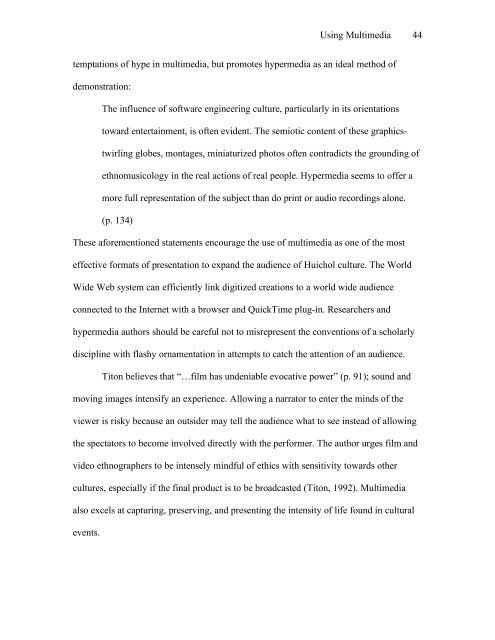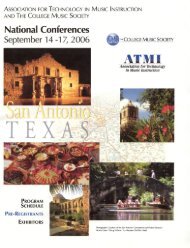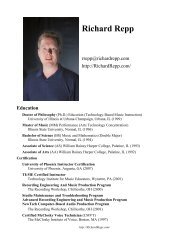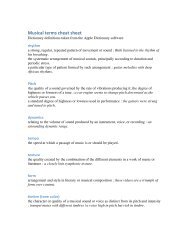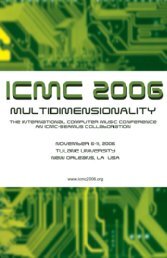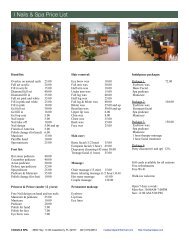Using Multimedia to Expand the Audience of ... - Richard Repp
Using Multimedia to Expand the Audience of ... - Richard Repp
Using Multimedia to Expand the Audience of ... - Richard Repp
Create successful ePaper yourself
Turn your PDF publications into a flip-book with our unique Google optimized e-Paper software.
<strong>Using</strong> <strong>Multimedia</strong> 44<br />
temptations <strong>of</strong> hype in multimedia, but promotes hypermedia as an ideal method <strong>of</strong><br />
demonstration:<br />
The influence <strong>of</strong> s<strong>of</strong>tware engineering culture, particularly in its orientations<br />
<strong>to</strong>ward entertainment, is <strong>of</strong>ten evident. The semiotic content <strong>of</strong> <strong>the</strong>se graphicstwirling<br />
globes, montages, miniaturized pho<strong>to</strong>s <strong>of</strong>ten contradicts <strong>the</strong> grounding <strong>of</strong><br />
ethnomusicology in <strong>the</strong> real actions <strong>of</strong> real people. Hypermedia seems <strong>to</strong> <strong>of</strong>fer a<br />
more full representation <strong>of</strong> <strong>the</strong> subject than do print or audio recordings alone.<br />
(p. 134)<br />
These aforementioned statements encourage <strong>the</strong> use <strong>of</strong> multimedia as one <strong>of</strong> <strong>the</strong> most<br />
effective formats <strong>of</strong> presentation <strong>to</strong> expand <strong>the</strong> audience <strong>of</strong> Huichol culture. The World<br />
Wide Web system can efficiently link digitized creations <strong>to</strong> a world wide audience<br />
connected <strong>to</strong> <strong>the</strong> Internet with a browser and QuickTime plug-in. Researchers and<br />
hypermedia authors should be careful not <strong>to</strong> misrepresent <strong>the</strong> conventions <strong>of</strong> a scholarly<br />
discipline with flashy ornamentation in attempts <strong>to</strong> catch <strong>the</strong> attention <strong>of</strong> an audience.<br />
Ti<strong>to</strong>n believes that “…film has undeniable evocative power” (p. 91); sound and<br />
moving images intensify an experience. Allowing a narra<strong>to</strong>r <strong>to</strong> enter <strong>the</strong> minds <strong>of</strong> <strong>the</strong><br />
viewer is risky because an outsider may tell <strong>the</strong> audience what <strong>to</strong> see instead <strong>of</strong> allowing<br />
<strong>the</strong> specta<strong>to</strong>rs <strong>to</strong> become involved directly with <strong>the</strong> performer. The author urges film and<br />
video ethnographers <strong>to</strong> be intensely mindful <strong>of</strong> ethics with sensitivity <strong>to</strong>wards o<strong>the</strong>r<br />
cultures, especially if <strong>the</strong> final product is <strong>to</strong> be broadcasted (Ti<strong>to</strong>n, 1992). <strong>Multimedia</strong><br />
also excels at capturing, preserving, and presenting <strong>the</strong> intensity <strong>of</strong> life found in cultural<br />
events.


